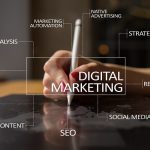Introduction
In recent years, artificial intelligence (AI) has become one of the most talked-about topics in the world of tech. And while it may seem like AI is only for developers and techies, the reality is that it can be a powerful tool for marketers, too.
In this article, we’ll be introducing you to how AI differs from common automation tools and provide you with specific examples of how you can integrate it into your work as a digital marketer.
What is AI and Why Should Marketers Care?
AI is a broad term that covers a range of technologies, many of which can be very useful for today’s busy digital marketer. From natural language processing, which interprets and writes text, to image processing, which recognizes elements in images and video, AI tools have become a huge part of helping us communicate our ideas.
At its core, AI is all about making computers smarter so they can do what us marketers already do, but faster and more efficiently. For a social media manager, this might mean that AI can automate everyday tasks like monitoring comments and responding to negative ones. For a marketing analyst, it might instead mean getting data to better understand market segments, which help them make better decisions.
You might think, “I use plenty of automation tools without AI.” That is true! When creating email sequences for instance, a lot of things happen automatically, but AI takes automation to a completely new extent.
AI does much more than automate simple rules. The AI tools we’ll be discussing in this article can suggest new ideas, write tweets and create videos. The AI models behind these tools not only save you time but can come up with something completely now.
How Can Marketers Use AI Without Being Developers?
There are a very large number of AI applications that marketers can use without any coding knowledge. As AI keeps improving, the number of possibilities keeps increasing as well.
However, we want to make this article as practical as possible and will be focusing on 3 main areas of marketing that can use AI tools: digital advertising, social media management, and content marketing.
Digital Advertising
Automated Insights
One of the most common ways AI is used in marketing is for automated insights. This is where AI analyzes data (such as website traffic data or customer purchase data) and generates insights that can be used to improve marketing campaigns.
For example, you could use AI to analyze the ad copy that is used to learn about what kind of messaging connects best with your audience. Flowin, a tool we’ll be discussing below, does just that.
Customer Segmentation
Customer segmentation is another common use for AI in marketing. This is where AI is used to group customers into different segments based on their characteristics.
This is a more specific use of AI’s analysis capabilities, that helps replace a task that traditionally was very subjective. Marketers normally segment customers based on their age, gender, location, or interests, but on their experience. On the other hand, using AI allows you to be much more certain of those segments.
One of the tools we’ll mention not only does the work of segmenting users but also searches social media and forums to better understand what your segment is really talking about.
You could then use this information to create more targeted marketing campaigns that respond to the issues that are top of mind for your target market. You’d be able to know that based on trending Reddit threads and popular Facebook posts, your audience would be very interested in a specific aspect of your product.
Personalization
Personalization is another common use for AI in marketing. This is where AI is used to personalize content for specific groups of people.
For example, you could use AI to personalize email content based on the different products that your customers have purchased.
Write personalized advertising deadlines and descriptions for each segment and do so in a much more automated way.
Social Media Management
Community Management
AI can be used to help you keep track of social media conversations about your brand, so you can quickly respond to comments that have a negative tone. Social media monitoring is another common use for AI in marketing.
Tools that fall under this category, like MonkeyLearn, to monitor social media profiles and provide instructive insights that help your team better understand the community.
Brand monitoring
Brand monitoring tools have been around for a while and provide a great example of tools that make use of AI for marketing in their main features and can still add a lot of value to existing processes.
While you might normally go through the feed that social monitoring tools can provide, looking for important mentions and then thinking of opportunities to respond, AI tools can do this all for you. Information can be filtered and grouped to provide you with a clear sight of where opportunities lie.
You could then use this information to engage with customers or make changes to your marketing campaigns based on the feedback you’ve been getting on what’s important for your customers.
Content Marketing
Content Recommendations
We mentioned earlier that certain tools could crawl social media platforms to learn about your audience. These tools provide you with a list of interesting topics, but how do you know what to write about? Well, you must have guessed at this point that there’s an AI tool that can help you with that task too.
If blogging is part of your strategy, you could use AI to recommend new blog ideas for your customers. Based on a list of topics, a tool like Jarvis.ai can help you think of more specific ideas that could be perfect for your blog.
Creating Creation
The most amazing aspect of AI tools are how they can even create the content itself. Content creation is a time-consuming process that can take your SEO marketers and writers a lot of time. AI tools are amazing at writing content that can save your team time and money.
Not only can these tools write drafts of blog posts, but they can also write Facebook posts, Tweets, and more.
5 Tools to Get Started With AI in for Your Marketing
Now, if you’re convinced you can be using AI today there are a number of tools out there that can help you do that. We’ve already mentioned a few when discussing their application above, but below we’ll provide you with a step-by-step explanation of how you can begin using AI today.
1. Flowin
Flowin is a company that focuses on text generation, but unlike other tools, their focus is specifically in performance marketing. Flowin first studies your advertising campaigns to find what works and doesn’t work in your ad campaigns before suggesting new ideas for you to A/B -test.
How to start using Flowin

- Sign up for Flowin’s free plan or sign up for the paid plan trials
- Integrate with your Google and Facebook advertising accounts
- Review the sentiments that are most important in your ads
- Use Flowin’s AI to develop fresh ads ready to be tested
- Export those ads into your campaigns
2. Jasper
Jasper (formally Jarvis) is certainly one of the leaders when it comes to AI-generated content. Their focus on language models allows their users to create new texts ranging from advertising headlines to long-form blog posts.
How to start using Jasper

- Think about how your existing blog strategy could be improved with new content
- Create an outline of the next 5-10 posts that you’d like to have on your blog
- After signing up for Jarvis (trial is available), go to the types sections and select blog
- Have the AI tool write your first draft
- Copy the draft into our website post builder and finalize the article.
3. Crawl lQ
Unlike the two above tools that focus on implementing new text and Crawl IQ is a marketing research tool. If you’ve ever spent hours looking through the internet to better understand your audience, Crawl IQ might come in handy.
How to start using Crawl IQ

- Create your own audience defining their age, location, and interests
- Review the platforms that are available for scraping
- Once your learnings are extracted, export them for your own analysis
- Create new content ideas out of the insights and make use of them in throughout your communication channels.
4. MonkeyLearn
MonkeyLearn is a great tool for managing your community and taking learning customer feedback to the next level. What’s especially special about MonkeyLearn is a custom grouping feature we’ve not seen in many other applications.
If you’d like, for instance, to see all the comments where users mention the price you can begin tagging social media comments within the tool, and the AI will begin to recognize the pattern and begin tagging comments for you.
How to start using MonkeyLearn

- Connect your sources of user feedback
- With the help of the AI, add tags that range from the topics of sentiment or feature requests
- Review the insights dashboards of the tools and create your own report sharing insights with your team
- Next time your team discusses customer feedback, make sure you re-upload your data to MonkeyLearn first to get new insights into your customers.
5. Lumen5
Whether you’re creating video content for your blog or for ads, the process is incredibly expensive and time-consuming. Lumen5 automatically creates those videos for you. One great application of Lumen5 is advertising, but they can also be used for much more.
How to start using Lumen5

- Write a script for a video that you’d like to use in an upcoming campaign or for an ad that you would want to create.
- Paste that script into the platform and let the AI do its thing.
- Review the video in the editor and make your desired changes.
- Export the video and use it in your next campaign!
Conclusion
We hope this article didn’t overwhelm you! AI is powerful, and there’s definitely a lot to talk about. As these tools become more commonplace, marketers will end up doing fewer and fewer repetitive tasks, which means more time for real thinking!
The AI tools we presented can offer an incredible competitive advantage when properly implemented, so we hope you take the time to at least give one a try!






